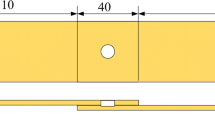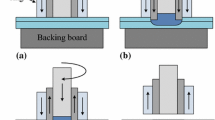Abstract
Refill friction stir spot welding (RFSSW) was applied to weld 2024-T4 aluminum alloy and effects of welding parameters on the fracture mechanisms of RFSSW tensile-shear specimens were investigated. Fracture modes are mainly determined by the bonding strengths of the lap interface and the stir zone (SZ)/thermomechanically affected zone (TMAZ) interface, which are largely influenced by heat input and sleeve plunge depth. Reasonable heat input leads to shear-plug fracture mode, which owns better mechanical properties in general. When sleeve does not penetrate into the lower plate, hook is flat and bonding ligament is continuous, shear fracture mode happens. Increased heat input improves diffusion bonding effect of the SZ/TMAZ interface but decreases hardness in SZ, which also results into shear fracture mode. Big sleeve plunge depth and downward bending hook lead to plug fracture mode. Fracture positions and fracture morphologies agree with the corresponding fracture mechanisms.
Similar content being viewed by others
References
Song X, Ke LM, Xing L, Liu FC, Huang CP (2014) Effect of plunge speeds on hook geometries and mechanical properties in friction stir spot welding of A6061-T6 sheets. Int J Adv Manuf Technol 71:2003–2010
Karthikeyan R, Balasubramanian V (2010) Predictions of the optimized friction stir spot welding process parameters for joining AA2024 aluminum alloy using RSM. Int J Adv Manuf Technol 51:173–183
Mazzaferro JAE, Rosendo TS, Mazzaferro CCP, Ramos FD, Tier MAD, Strohaecker TR, dos Santos JF (2009) Preliminary study on the mechanical behavior of friction spot welds. Soldagem Insp 14(3):238–247
Shen ZK, Yang XQ, Zhang ZH, Cui L, Li TL (2012) Microstructure and failure mechanisms of refill friction stir spot welded 7075-T6 aluminum alloy joints. Mater Des 44:476–486
Pan T, Santella M, Blundell N (2009) Friction stir spot welding for structural aluminum sheets. SAE Int J Mater Manf 2(1):23–29. doi:10.4271/2009-01-0023
Iwashita T (2003) Method and apparatus for joining. US Patent 6601751:B2
Yang XW, Fu T, Li WY et al. (2014) Friction stir spot welding: A review on joint macro and microstructure, property, and process modelling. Adv Mater Sci Eng 697170. doi: http://dx.doi.org/10.1155/2014/697170
Pieta G, dos Santos JF, Strohaecker TR, Clarke T (2014) Optimization of friction spot welding process parameters for AA2198-T8 sheets. Mater Manuf Process 29(8):934–940. doi:10.1080/10426914.2013.811727
Uematsu Y, Tokaji K, Tozaki Y, Kurita T, Murata S (2008) Effect of re-filling probe hole on tensile failure and fatigue behavior of friction stir spot welded joints in Al-Mg-Si alloy. Int J Fatigue 30:1956–1966
Han B, Huang YX, Lv SL, Wan L, Feng JC, Fu GS (2013) AA7075 bit for repairing AA2219 keyhole by filling friction stir welding. Mater Des 51:25–33
Tier MAD, dos Santos JF, Rosendo T et al. (2008) The influence of weld microstructure on mechanical properties of alcald AA2024-T3 friction spot welded. SAE technical paper 2008-01-2287
Patnaik A, Koch K, Arbegast W et al. (2006) Static properties of “refill” friction spot welded skin stiffened compression panels. SAE technical paper 2006-01-0967
Suhuddin U, Fischer V, Kroeff F, dos Santos JF (2014) Microstructure and mechanical properties of friction spot welds of dissimilar AA5754 Al and AZ31 Mg alloys. Mater Sci Eng A 590:384–389
Oliveira PHF, Amancio-Filho ST, dos Santos JF, Hage JE (2010) Preliminary study on the feasibility of friction spot welding in PMMA. Mater Lett 64:2098–2101
da Silva AAM, dos Santos JF, Rosendo TR et al. (2007) Performance evaluation of 2-mm thick alclad AA2024 T3 aluminum alloy friction spot welding. SAE technical paper 2007-01-3812
Suhuddin UFH, Fischer V, dos Santos JF (2013) The thermal cycle during the dissimilar friction spot welding of aluminum and magnesium alloy. Scripta Mater 68:87–90
Kakarla SST, Muci-Küchler KH, Arbegast WJ, Allen CD (2005) Three-dimensional finite element model of the refill friction stir spot welding process. In: Jata KV, Mahoney MW, Mishra RS, Lienert TJ (eds) Friction stir welding and processing III. The Minerals, Metals and Materials Society, Warrendale, pp 213–220
Zhao YQ, Liu HJ, Chen SX, Lin Z, Hou JC (2014) Effects of sleeve plunge depth on microstructures and mechanical properties of friction spot welded alclad 7B04-T74 aluminum alloy. Mater Des 62:40–46
Shen ZK, Yang XQ, Yang S, Zhang ZH, Yin YH (2014) Microstructure and mechanical properties of friction spot welded 6061-T4 aluminum alloy. Mater Des 54:766–778
Rosendo T, Parra B, Tier MD, da Silva AM, dos Santos JF, Strohaecker TR, Alcantara NG (2011) Mechanical and microstructural investigation of friction spot welded AA6181-T4 aluminum alloy. Mater Des 32:1094–1100
Tier MAD, Rosendo TS, dos Santos JF, Huber N, Mazzaferro JA, Mazzaferro CP, Strohaeckerd TR (2013) The influence of refill FSSW parameters on the microstructure and shear strength of 5042 aluminum welds. J Mater Process Technol 213:997–1005
Jafarian M, Khodabandeh A, Manafi S (2015) Evaluation of diffusion welding of 6061 aluminum and AZ31 magnesium alloys without using an interlayer. Mater Des 65:160–164
Siddiquee AN, Pandey S (2014) Experimental investigation on deformation and wear of WC tool during friction stir welding (FSW) of stainless steel. Int J Adv Manuf Technol 73:473–486
Jonckheere C, de Meester B, Cassiers C, Delhaye M, Simar A (2012) Fracture and mechanical properties of friction stir spot welds in 6063-T6 aluminum alloy. Int J Adv Manuf Technol 62:569–575
Author information
Authors and Affiliations
Corresponding author
Rights and permissions
About this article
Cite this article
Li, Z., Ji, S., Ma, Y. et al. Fracture mechanism of refill friction stir spot-welded 2024-T4 aluminum alloy. Int J Adv Manuf Technol 86, 1925–1932 (2016). https://doi.org/10.1007/s00170-015-8276-7
Received:
Accepted:
Published:
Issue Date:
DOI: https://doi.org/10.1007/s00170-015-8276-7




